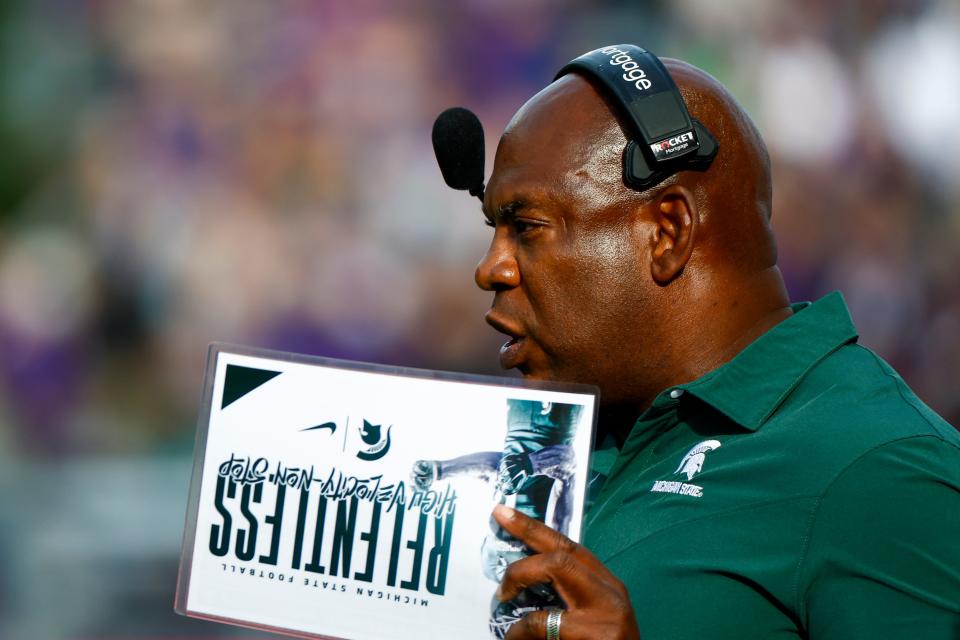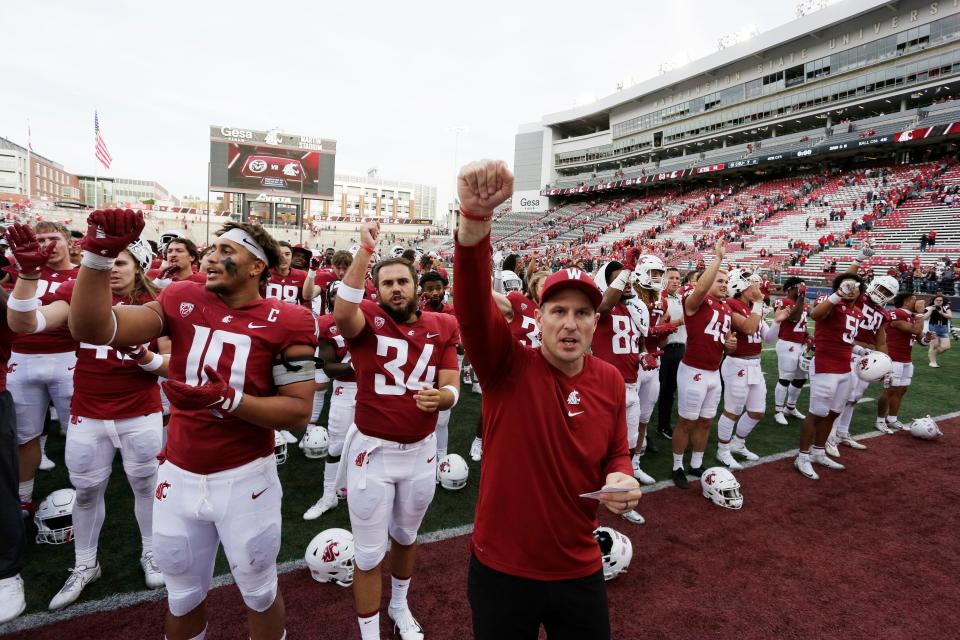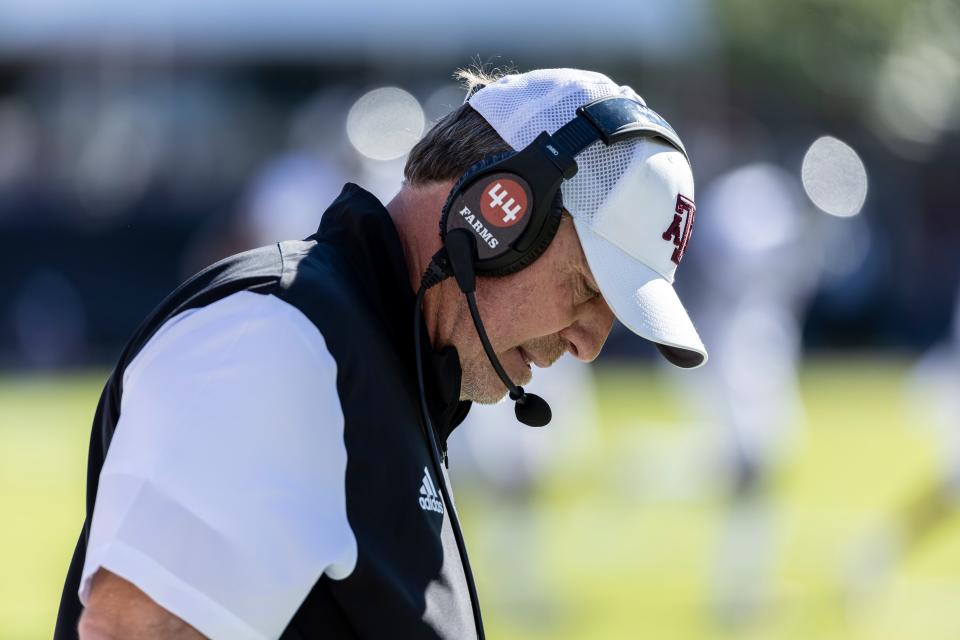'Not a risk at all': Why college football coaches are guaranteed more money than ever
Michigan State athletics booster Mat Ishbia didn’t really consider the financial risk last year when he decided to help fund a fully guaranteed 10-year, $95 million contract for football coach Mel Tucker.
It didn’t even matter to him that Tucker only had two previous seasons of experience as a college head coach with a combined record of merely 7-12. Ishbia said he still committed millions of dollars per year to pay for Tucker’s new deal, disregarding the possibility that Tucker’s tenure might turn sour someday, just like it does for so many coaches in a sport where half the teams must lose every Saturday.
“It doesn’t enter the equation at all,” Ishbia told USA TODAY Sports in an interview Dec. 6, shortly after MSU gave Tucker his new contract amid last year’s 11-2 season. “It’s not about his record. It’s not about what you see on TV. It’s about the person and knowing the guy and knowing that he’s a winner. There’s not a risk at all. Michigan State is not paying him to go 10-2 every year. Michigan State is paying him to be a leader.”
Such an outlook is far from unusual among university leaders and boosters in major college football. Why else have they increasingly guaranteed eight-figure sums to so many coaches who are destined to struggle at some point, just like Tucker has this year with his current three-game losing streak?
This year, a record 41 coaches in major college football had buyout stipulations in their contracts that guaranteed they would be paid at least $10 million if they are fired for losing too many games, according to public-school data compiled by USA TODAY Sports based on a hypothetical termination date of Dec. 1, 2022.

That includes the largest standing buyout in college football history – $103 million, which would be owed to Georgia coach Kirby Smart in the unlikely event he got fired this year for poor performance on the field. The list also includes buyouts of about $87 million for Tucker and Texas A&M’s Jimbo Fisher, both of whom are guaranteed by their schools to make about $95 million over 10 years through 2031.
Since Sept. 11, three schools even decided it was better to pay their coaches at least $10 million each to go away than let them finish the season – Nebraska, Georgia Tech and Wisconsin, which fired Paul Chryst on Sunday. Chryst was owed about $20 million according to his contract but agreed to take $11 million instead by Feb. 1. His record was 67-26 in eight seasons.
“I felt at this point in time a change was needed,” Wisconsin athletic director Chris McIntosh said.
Why buyouts spiral up
Similar huge buyouts and guaranteed deals have exploded since 2017, when there were “only” 26 coaches with buyout stipulations of at least $10 million as of Dec. 1 that year, led by $40 million for Clemson’s Dabo Swinney.
Four of those coaches were fired that year, putting their schools on the hook to pay them at least that much, though some of those amounts were negotiated down or later offset by pay those coaches earned in subsequent jobs, as is often the case with these buyout arrangements. Another three of those coaches were fired a year later.
The expenses still end up being huge for those who gambled on the wrong guy and lost, much like Notre Dame did when they gave Charlie Weis a 10-year contract in 2005. Notre Dame then ended up paying him about $19 million in buyout money after firing him in 2009, when his team finished 6-6.
So why keep making bigger gambles when only 51 of 130 major college teams last season (39%) were able to finish with records better than 7-6?
Schools say it’s driven by market forces, fueled by escalating revenue from media rights deals (and not direct taxpayer or student funds). But that doesn’t mean it’s rational. It’s actually grown increasingly less so, according to some economists. Which raises another curious issue: Why should it be rational if there’s money to burn and guys like Ishbia want to help pay for it, too?
“It has baffled me for some time,” said John Siegfried, emeritus economics professor at Vanderbilt.
Siegfried co-authored an academic article in 2012 that examined aggressive spending in college sports despite the fact they are “zero-sum” games in which half the teams lose every week and half will finish in the bottom half of the league standings. Success for every coach therefore is not possible, let alone at the elite level of success that is expected when these contracts are signed.
Times are changing, too. Player recruits no longer might pick a school based on the coach. They might chase the money instead after recently being allowed to earn it off of their names, images and likenesses (NIL).
“That further devalues the role of the coach,” said David Berri, an economics professor at Southern Utah. “Before (NIL), athletes chose on the basis of wins and losses. But if they are choosing schools based on NIL deals, then you don't need a great coach. You need a great NIL agent!”
Why schools give away so much
Perhaps the biggest reason schools get fleeced in these one-sided deals is because they don’t use their leverage in contract negotiations with these coaches and their agents, Siegfried said. Or they don’t think they have any leverage during this critical stage when they are eager to hire a coveted coach and don’t want to consider the sad thought that he might not work out.
"I’ve been in these negotiations myself as an (athletic director), and I can tell you when you talk to the (coaches') agents, they want everything fully guaranteed, and it just depends on whether you’ve got the discipline and the strength and the backing to say, `No, we’re not doing that,' " said Todd Turner, a former athletic director at Washington and other schools who now runs Collegiate Sports Associates, an executive search firm. "That’s where we as an industry have not had courage."
For example, what if A&M told Fisher during contract negotiations it would only be willing to guarantee half or some of his $95 million contract unless the school decided he was worthy of staying employed there all 10 years? Some schools do only guarantee to pay out some of the money left on a contract – not all – in the event of a termination.
“Fisher could say, 'I’ll walk to Auburn or somewhere,’ ” Siegfried said.
It's possible Fisher might not care that much about a full guarantee, even if his agent would.In 2011, then-San Diego State coach Rocky Long said he wasn’t interested in a “fancy buyout clause” and agreed to accept only $315,000 in buyout pay if he were fired for losing too many games. He ended up guiding the Aztecs to winning seasons for nine consecutive years before leaving voluntarily.
If the coach – or his agent – still insist on huge buyout clauses to match the market, the school also could push back by saying some other coach might do just as well for less money.
The problem is many schools – and the search firms that work for them – might not be willing to do the work necessary to identify such overlooked or up-and-coming coaches, according to Siegfried. Or the schools feel pressure to not get "left behind" the competition that is giving their coach more, Turner said. Or they don’t want to take a chance on a candidate who isn’t already a celebrity in the field and therefore is more difficult to “sell” to their fan base.

But there is no shortage of good coaches who are not celebrities. Washington State stumbled into one last year after its previous head coach was fired for not getting vaccinated against COVID-19. Current WSU coach Jake Dickert previously coached in the lower rungs of college football but has gone 4-1 this season after taking over in difficult circumstances. His pay is $2.7 million this year, and his buyout for getting fired without legal cause would be only about $3.7 million as of Dec. 1.
“Football coaching is not a unique skill,” Berri said. “They all know the same stuff, and they all watch the same film. And they all make the decisions. And it’s pretty damn obvious. The idea that I’ve got to give this one $8 million because he’s special – he’s not special. Every year, they fire coaches, because half of them lose. They fire the ones that ended up on the wrong end of the lottery. It is a lottery. You’re coaching kids.”
The fame and brand factor
It’s not a lottery every season for some elite coaches, however. Coaches such as Alabama’s Nick Saban are so famous and have such long records of high success that they keep attracting the best players in recruiting. Then they keep winning and gain the market power to command the best contract terms.
Yet even Saban’s contract is not fully guaranteed like Fisher’s and Tucker’s. In the unlikely event Saban were to be fired for losing too many games before 2026, he would get 48 months of pay and not all the money owed him by contract through Feb. 28, 2030. That’s about $43 million as of Dec. 1, about half that of Fisher and Tucker.
And not many coaches are at Saban’s level in terms of fame and success.
“The problem is the top athletes are going to choose the schools that win the most,” Berri said, noting that NIL earnings potential is part of the equation now too. “If you’re not one of the top handful of schools, you’re going to get the second-tier athletes, and that’s it. There’s not a whole lot you can do to fix that, barring you getting lucky.”
Then there’s the demotivational factor that comes into play with these giant guaranteed contracts, Siegfried said. If a coach’s contract is fully guaranteed for 10 years, why should he coach like his livelihood depends on every game or season?
Do big buyouts make coaches less hungry?
This becomes suspected each time a coach with an enormous, guaranteed contract suffers an upset loss or runs into extended trouble on the field.
After A&M increased Fisher’s financial security in 2021, the Aggies finished 8-4. This year, they’re 3-2 with losses to Appalachian State and Mississippi State, renewing criticism of his contract from fans and observers.
Was it really necessary for A&M to fully guarantee $95 million through 2031? Unlike Tucker’s contract, if Fisher got fired, his contract doesn’t even require him to try to get a job somewhere else and then use his pay there to offset what he’s owed by A&M after his termination.
The university “will not be entitled to any offset whatsoever in the event that coach secures any subsequent employment,” his contract states.
Why did A&M agree to that?
A&M generally didn't want to go "backwards" on his contract, athletic director Ross Bjork said. That stipulation was included in Fisher’s original fully guaranteed contract after he was hired in late 2017 by athletic director Scott Woodward, who now is at LSU. Fisher then got a new contract and a raise in 2021 under Bjork.

"Look, obviously there was a trend that was set when Texas A&M hired Coach with a fully guaranteed contract,” Bjork told USA TODAY Sports. “We had no intention of going backwards on that in extending him. And, so, then what you've seen since is many other universities go in that direction where ... I think it's all about stability. Stability and continuity.”
At Colorado, fans and alumni bemoan how head coach Karl Dorrell was given a fully guaranteed $18 million contract in early 2020 despite having no apparent competition for his services at the time.
CU has gone 4-15 since starting 4-0 under Dorrell in 2020. On Sunday, the school fired him after an 0-5 start this season, leaving CU on the hook to pay him the $8.7 million left on his contract, though he has a duty to find employment elsewhere and use his new pay to offset what CU owes him.
Was it really necessary for CU to guarantee his whole contract of $18 million through 2024?
CU athletics spokesman David Plati noted that shortly before his hiring at CU, Dorrell had been promoted to assistant head coach of the Miami Dolphins. Coaches are taking risks, too, when they leave one seemingly safe job for another in a volatile profession. Their agents demand financial security in return.
Two prominent coach agents, Russ Campbell and Patrick Strong of Balch Sports, told USA TODAY Sports that financial liability for schools is rising, in part, because they are firing coaches earlier in their contracts.
"If the track record shows that it’s very unlikely the hiring school will actually give you the five or more years to build and coach out your contract, anyone in their right mind would insist upon a fully guaranteed deal in order to uproot your family," they said.
At Michigan State, Tucker got more financial certainty after finishing 2-5 during the pandemic season of 2020 and then starting 8-0 in 2021, sparking speculation he might be courted for an opening at Louisiana State. Ishbia said MSU athletic director Alan Haller reached out around that time and asked, “Hey, how do we make sure we let Mel knows we love and appreciate him?”
The booster factor
In late November, MSU announced Tucker’s new contract, saying it was “an investment in a promising future for Spartan football” and “not based on one year of results.”
Ishbia said he committed to pay some of it, spread out over the term of the contract. He knew what kind of investment he was making for MSU. After all, he is a successful businessman as president and CEO of United Wholesale Mortgage. He also knows sports and good coaches, having played for MSU basketball legend Tom Izzo.
Ishbia said it was important for the school to send the message it is fully committed to Tucker.
“It’s like in a marriage: Are you half guaranteed on the marriage?” Ishbia said in the Dec. 6 interview with USA TODAY Sports “Or are you actually fully in? Michigan State is fully in with Mel, and he’s fully in with us, and that’s how we think about it. I don’t need a ‘Well, if things don’t go well after Year Six, I can pay you less to get you to leave.’ If things don’t go well after Year Six, you know what we’ll do? We’ll sit down. We’ll meet, obviously. I’m not part of this, but this is how we run business: You sit down. You meet, and you figure out what we need to do to make Year Seven better, not throw him out the door.”
He also is not naïve about risks.
“Is there is a risk?” he asked. “Yeah, there’s a lot of risk. There’s a risk in everything you do. There’s a risk in not doing it also. I’d argue there’s bigger risk in not keeping great people around your team and being worried about what if happens down the road.”
Similar sentiments among boosters around the country help pay for these contracts – and help bail out the schools when the bet turns out to be a bust.
The cycle then continues. The school responds by making a bigger gamble on a different coach and hopes he’ll have enough talent and good fortune to be among the 28 teams or so out of 130 (22%) that win at least 10 games. That’s how many won 10 games last season and in 2019-20, the last season before COVID-19.
If boosters are willing to help pay for it and the media rights money keeps flooding schools’ bank accounts, why not? The schools’ labor expense for players is still generally capped by rule at the cost of attending college.
That leaves plenty for terminated coaches, many of whom have made good livings off of getting fired and not coaching.
Weis is perhaps the most famous example. Along with his buyout from Notre Dame, he also was paid about $5.4 million from Kansas after getting fired there in 2014 with a 6-22 record. Likewise, Auburn was on the hook to buy out coach Gus Malzahn for $21 million after firing him in late 2020. Half of that was due to him within 30 days of his termination, with the rest due in installments over four years. The contract didn’t even require him to offset that amount with future pay at a new job.
There are many other examples. And more are on the way.
It’s practically guaranteed.
Follow reporter Brent Schrotenboer on Twitter @Schrotenboer and e-mail him at bschrotenb@usatoday.com. Follow reporter Steve Berkowitz on Twitter @ByBerkowitz
This article originally appeared on USA TODAY: Why college football coaching buyouts are bigger than ever

 Yahoo Movies
Yahoo Movies 
